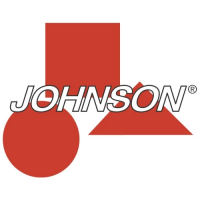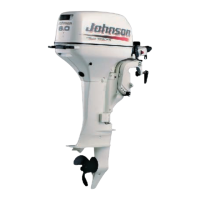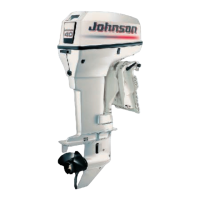38 - Maintenance
PRE-SEASON SERVICE
Remove your outboard from storage and prepare it
for a season of reliable service by performing a gen-
eral check and a few preventive maintenance pro-
cedures.
Examine all loosened or removed hardware and
any steering, throttle, and shift systems. Replace
damaged or missing parts with
Evinrude/Johnson
Genuine Parts
or equivalent.
Engine Oil — Check the engine oil level. Refer to
Crankcase Oil and Filter.
With the propeller removed, check the gearcase for
leakage. If leakage is evident, the gearcase seals
should be replaced. See your Dealer.
Anticorrosion anodes — Check condition. Refer
to Anticorrosion Anodes.
Install the propeller unless you will run the engine
on a flusher for your pre-season servicing. If so, in-
stall the propeller after you shut OFF the engine
and disconnect the flusher. Refer to Flushing.
Refer to Propeller to install the propeller.
Top off fuel tank with fresh fuel.
Battery — Charge fully and install. Refer to Bat-
tery.
Refer to Engine Monitoring and review your en-
gine’s warning system self-test routine. During your
preseason start-up, make sure the warning system
self-tests properly. If it does not, see your Dealer.
Follow Engine Starting and start the engine. Let it
idle while you:
Observe running quality – if poor, refer to Trouble
Check Chart or see your Dealer.
Observe water pump operation. Water must flow
from the water pump indicator in a steady stream. If
it does not, shut OFF the engine and investigate.
Refer to Engine Overheating.
Stop the engine and check the fuel system for
leaks.
WARNING
Failure to carefully reattach the outboard
and its control systems with factory-speci-
fied hardware can result in sudden, unex-
pected loss of boat control.
WARNING
Prevent accidental contact with a rotating
propeller; always remove it when using a
flusher to run the engine.
WARNING
Do not use a booster battery and jumper
cables to start the engine. Fumes vented
can cause explosion and fire, resulting in
property damage, serious injury, or death.
WARNING
Failure to check for fuel leakage could allow
a leak to go undetected, resulting in fire or
explosion.

